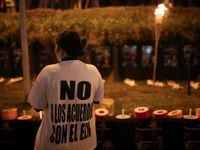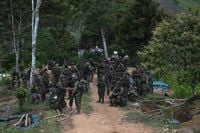On the afternoon of September 7, 2025, the rugged, coca-rich hills of Colombia’s Cauca department became the stage for a dramatic episode that underscores the country’s ongoing struggle with armed groups and the lingering fallout from decades of internal conflict. At least 72 Colombian soldiers, deployed on a mission to disrupt drug trafficking and illegal mining operations, were suddenly detained in San Juan de Micay—a hotspot for illicit crop cultivation and a stronghold of a renegade FARC faction known as the Central General Staff, according to AFP and Reuters.
The soldiers’ deployment was part of a broader government offensive launched by President Gustavo Petro in 2024 to reassert state control over territories long dominated by dissident groups. But as the troops moved through the region, their progress was halted—not by open gunfire, but by a mass of roughly 600 civilians. According to the Colombian army and multiple news agencies, these civilians, acting under the pressure and orders of local armed groups, physically blocked the soldiers’ movement, effectively detaining them.
Such incidents have become alarmingly common in Colombia’s lawless regions. As the BBC and Reuters note, local communities—caught between the state and armed groups—are often coerced into acting as human shields or instruments of guerrilla strategy. The Colombian government maintains that these detentions are seldom spontaneous, instead orchestrated by dissident rebel leaders who rejected the historic 2016 peace agreement with the Revolutionary Armed Forces of Colombia (FARC).
By the evening of September 7, the army had managed to extract 27 of the detained soldiers. Still, 45 remained held by the mass of civilians in the rebel-controlled area. The military’s official statement, as reported by AFP, emphasized that “the National Army maintains a presence in the area, taking steps to restore order and ensure the return of the kidnapped personnel.” The soldiers’ mission—intended to disrupt the lucrative trafficking routes and illegal mining operations—had been abruptly derailed.
President Gustavo Petro, who has staked much of his administration on negotiating peace with Colombia’s remaining armed groups, responded swiftly. Taking to social media, he urged the release of the soldiers, appealing to the shared humanity of those involved: “Let the soldiers go free, they can be your children. The children of Colombia must embrace and outlive their parents,” he posted on X (formerly Twitter) on September 7. Petro also called for a dialogue commission to negotiate and reminded the peasantry of Micay that “it’s time to begin the peaceful substitution of (illicit) crops. This is the opportunity.”
Behind the president’s plea lies a grim reality: the Cauca department, and especially the Micay canyon, has become an epicenter of world coca production and a flashpoint in Colombia’s ongoing violence. After the 2016 peace deal, large swathes of territory once held by FARC were left with a power vacuum. As reported by Al Jazeera and Reuters, splinter groups, drug traffickers, and criminal organizations quickly moved in, often using intimidation to control local populations and resist state intervention.
The government’s frustration is palpable. Defense Minister Pedro Sanchez, in a series of posts on social media, condemned the “sequestration” of the soldiers as a “crime against humanity that does not have a statute of limitations and will be prosecuted by all international justice systems.” He specifically blamed rebels commanded by Ivan Mordisco, a notorious FARC dissident, for orchestrating the incident and demanded the soldiers’ immediate release.
As the hours ticked by, the situation remained tense but did not escalate into violence. According to CTV News and Reuters, mediation efforts—sometimes involving human rights groups—are a frequent feature of such standoffs. The government reported that, by September 8, all 45 remaining soldiers had been retrieved “without incident” by the Colombian air force, and all were returned “safe and sound.” President Petro confirmed on social media, “All military personnel in the hands of civilians have been released.”
This episode is not an isolated event. In June 2025, 57 soldiers were detained in the same region, only to be freed days later after military intervention. In late August, 33 soldiers were held captive for three days in a southeastern Amazonian community dominated by leftist guerrillas. So far in 2025, at least five similar incidents have occurred, most ending with the soldiers’ safe release after negotiations or pressure from authorities, as reported by Al Jazeera and AFP.
The reasons behind these recurring detentions are complex. Decades of civil conflict have left deep scars. Colombia’s six-decade internal war—pitting the government against leftist guerrillas, right-wing paramilitaries, and drug traffickers—has claimed over 450,000 lives, according to a 2022 truth commission report cited by Al Jazeera and Reuters. In some regions, historical grievances and distrust of the military run deep, further complicating the government’s efforts to restore order.
After the FARC’s demobilization, the Colombian state struggled to fill the vacuum, and armed groups—some led by former FARC commanders—consolidated control over lucrative coca-growing and gold-mining territories. The Central General Staff, the group blamed for the latest incident, is one such faction. Their influence over local populations is maintained through a mix of coercion, economic dependency, and fear, making it difficult for the government to assert its authority without risking further violence or civilian casualties.
In the aftermath of the latest detentions, authorities have vowed to prosecute those responsible. Defense Minister Sanchez stated that the kidnapping of troops “constitutes a serious violation of human rights and international humanitarian law.” Yet, the government’s options remain limited, as direct military confrontation risks inflaming tensions and harming civilians caught in the crossfire.
For ordinary Colombians living in these contested regions, the cycle of violence, intimidation, and instability is a daily reality. As President Petro’s administration continues its efforts to negotiate with armed groups and promote the substitution of illicit crops, the challenge remains enormous: how to break the grip of criminal organizations, rebuild trust with local communities, and finally bring lasting peace to areas that have known little else for generations.
This latest episode in Cauca is a stark reminder that, despite the 2016 peace agreement’s promise, Colombia’s path to stability is fraught with obstacles. The safe return of the 72 soldiers is a relief, but as history shows, the underlying issues—poverty, lawlessness, and the enduring power of armed groups—will require far more than military operations or presidential appeals to resolve.


